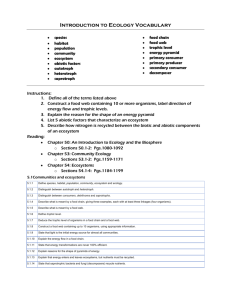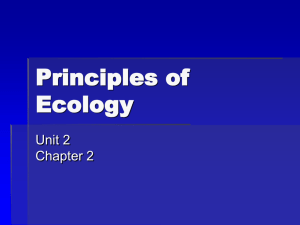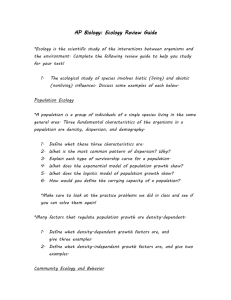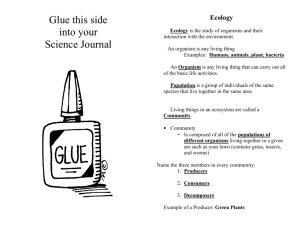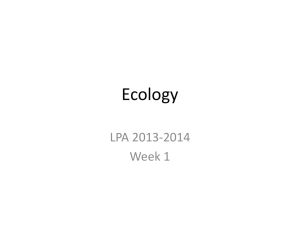Unit 2 Chapter 2 Principles of Ecology
advertisement
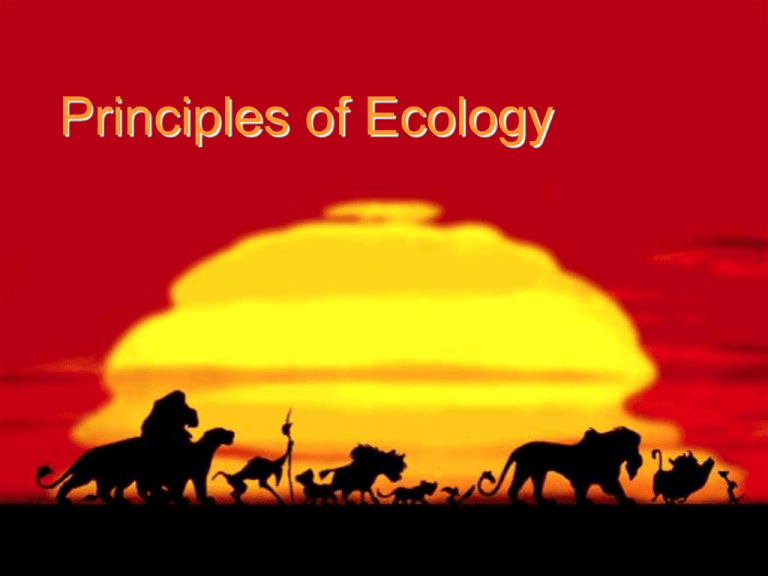
Principles of Ecology Unit 2 Chapter 2 What is ecology? • Ecology: study of interactions that take place between organisms and their environment Biosphere • the portion of the Earth that supports living things • Ex: ocean, forest, atmosphere. Abiotic vs. Biotic factors • Abiotic = nonliving parts of the environment • Ex: light, air, temperature, soil • Biotic = living parts of the environment • Ex: bacteria, protist, fungus, plant, animal Which is Biotic/Abiotic? Levels of organization • In biology, we begin at the chemical level which make up cells… • Which make tissues… • Organs… • Systems… • And finally, the individual organism Levels of organization from smallest to largest in an Ecosystem. • • • • • • Organisms Individual Population Community Ecosystem Biosphere Levels of organization • In Ecology, we begin with the individual and move through the levels to the planet, Earth Individual • made of cells, uses energy, reproduces, responds, grows, and develops Population • group of organisms all of the same species, which interbreed and live in the same area at the same time Community • interacting populations in a certain area at a certain time Ecosystem • interacting communities and abiotic factors Habitat vs. Niche • Habitat: place where organism lives • Niche: role or position a species has in its environment End of What is Ecology Notes? • Now let’s do some practice!!! Energy Flow Through an Ecosystem Notes Du (2) Ecology and the flow of energy and matter • By the end of this portion of the notes you should be able to describe how matter and energy flow through trophic levels using various models, including food chains, food webs and ecological pyramids How organisms obtain energy • Autotroph (producer): photosynthetic or chemosynthetic, makes own food • Heterotroph (consumer): “eat” other organisms, cannot make own food • Decomposer: breaks down dead or decaying organisms, recycles matter Autotroph The sugar produced by autotrophs (through photosynthesis) can then be used by heterotrophs for energy Heterotrophs - scavengers • Scavengers: feed off of dead or decaying living things but do not recycle matter back into the ecosystem Heterotrophs - herbivores • consume only vegetative matter • mostly primary consumers. Heterotrophs - carnivores • obtain energy from eating other consumers • Secondary and tertiary consumers Decomposers •Bacteria and fungi break down living matter and help release nutrients. •Decomposers are found at every level of the food chain. •They are nature’s recyclers. Typical examples: fungus and bacteria Autotrophs Third-order heterotrophs First-order heterotrophs Second-order heterotrophs Decomposers How Energy Flows • From producer (autotroph) to consumer (heterotroph) AUTOTROPH Water + CO2 Sugar + O2 HETEROTROPH Sugar + O2 water + CO2 Food chain • Series of steps in which organisms transfer energy by eating and being eaten • The arrows show the direction energy flows. • Trophic levels: feeding step berries → mice → black bear Food web • shows interactions between organisms (all possible routes) Energy pyramid • Shows how much energy is available at each trophic (energy) level. • Only 10% of the available energy is transferred up to the next trophic level. The rest is released as heat Pyramid of Energy Heat Heat 0.1% Consumers 1% Consumers 10% Heat Heat Consumers Pyramid of Numbers • Each level represents the number of organisms consumed by the level above it. End of Lecture 2 Now lets practice!! Ecology Notes 3 Cycles Two cycles in nature • Carbon cycle • Nitrogen cycle CO2 in Atmosphere • Carbon Cycle • driven by photosynthesis & respiration CO2 in Ocean • recycles carbon, a primary component of all organic compounds Carbon cycle Nitrogen Cycle • driven by decomposition of nitrifying bacteria and fungi • atmospheric nitrogen must be converted to a usable form (by plants) N2 in Atmosphere NH3 NO3 – and NO2 – Nitrogen cycle Now let’s Practice Time to Draw some cycles.
